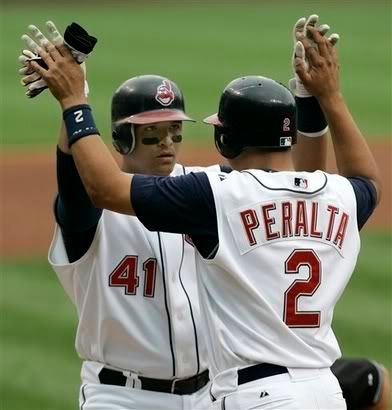 Shortstop’s pop has eased a major deficiency
Shortstop’s pop has eased a major deficiency
Jhonny Peralta was never the poster child of the Indians organization. He did not have the signing bonus of a Jeremy Guthrie. He did not come with the high ceiling label that Brandon Phillips enjoyed. What he did do, though, was produce at every level. And he accomplished it as just about the youngest player in each league he played in. Eventually the Indians, and scouts around the league, had to take notice.
Upon unseating Omar Vizquel in 2005, Peralta did his best to make Tribe fans forget about the fan favorite. In his first full season, he set a club record with homers by a shortstop, and was a huge part of a successful 93-win season. He was rewarded in the off -season with a handsome long-term contract. The future seemed bright.
Then came 2006. Peralta’s demise offensively was a microcosm of the disastrous play of the entire club. His power numbers were basically cut in half, with his average dipping nearly 30 points. He was not putting the bat on the ball, striking out an alarming 152 times. To further complicate things, Jhonny’s troubles at the plate magnified his deficiencies in the field. Had the Indians pinned part of their future on Jody Gerut?
Despite a winter vision procedure, it certainly seemed as if the league had adjusted to Peralta and that 2006 was no fluke. On April 23rd, his average had dipped to under .200 with just a pair of early seasons homeruns.
And then, everything started to change. Peralta regained his ability to drive the ball to right field. Furthermore, he began working deeper into counts and reducing his strikeouts dramatically. His presumed care-free demeanor now can be interpreted as simply even keel. Today he is on pace for a thirty homerun year, power that the Indians desperately needed.
Although the Indians had a glaring need for a right-handed power hitter, the area was not addressed in the off-season. Jhonny’s emergence is as important as anything else as to why the Indians are looking down at the rest of the central division. With perhaps the weakest corner outfielders in the American League, no pop in the middle infield would have been difficult to overcome. Peralta, along with Ryan Garko’s persistence to find his way into the starting lineup, has given the Indians a presence on the right hand side of the plate that seemed to be unattainable from within.
Long term, it remains unclear as to whether Jhonny Peralta can be athletic enough to handle playing shortstop at the major league level. Perhaps a move to third will be in the cards at some point. But the re-emergence offensively is a huge relief to the organization, and could pay dividends for years to come.